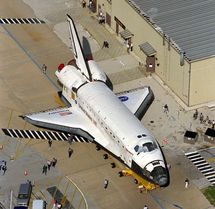
The shuttle's arrival, after shooting above Central America and the Gulf of Mexico, was announced with a triumphant double sonic boom that shook the air above the Florida space base.
The hundred-tonne glider descended for just over an hour from an altitude of 217 miles (350 kilometers), after NASA had previously scrapped their first landing attempt an hour-an-a-half earlier because of weather concerns.
In anticipation of a smooth landing, NASA said the crew spent part of Friday checking over the shuttle's flight control surfaces.
These components were needed "to guide the orbiter's unpowered flight through Earth's atmosphere," the space agency said in statement.
The shuttle's landing was mostly operated automatically by onboard computers, until flight controls were passed over for a manual descent the last three minutes.
Crew members had also checked for damage to the craft that may have been sustained during their flight -- a standard operating procedure after February 2003 when the Columbia shuttle disintegrated as it re-entered Earth's atmosphere, killing all seven crewmembers.
The accident was caused by a piece of debris that broke off the external tank at launch and struck one of Columbia's wings, gouging a hole in it. The shuttle program resumed with the first lift-off of Discovery in July 2005.
After packing and organizing the shuttle cabin, Discovery crew members Friday gathered on the flight deck to discuss their flight with students of Punahou School in Honolulu, Hawaii, NASA said.
Discovery docked at the ISS on March 17, two days after its launch. One of the mission's biggest tasks was to deliver the orbiting laboratory's last set of solar arrays, which were successfully unfurled March 20.
The ISS now has four solar panels, two per wing, containing 32,800 cells that convert sunlight into electricity.
They will boost the outpost's full power generation from 90 to 120 kilowatts, providing the power the space station needs to carry out scientific experiments in the European Columbus laboratory and Japan's Kibo lab.
During the mission, the shuttle crew and ISS residents enjoyed a 30-minute video conference call from the White House with President Barack Obama and a group of Washington schoolchildren.
Space-fan Obama, also flanked by lawmakers, peppered the crew with questions, wanting to know everything about life in space from the latest mission of the Discovery space shuttle to fitness, food and hairstyles.
"I'm told that you're cruising at about 17,000 miles per hour. So we're glad that you are using the hands-free phone," Obama told the astronauts floating several hundred miles above Earth.
"Mr President, we go around the planet once every 90 minutes. It's quite a thrill, and it is very fast, and we see 16 sunrises and 16 sunsets every day," said ISS commander Michael Fincke.
The next manned space launch, for the shuttle Atlantis, is scheduled for May 12 in a final mission to repair and maintain the Hubble space telescope.
Eight more shuttle launches are scheduled up to September 30, 2010 -- the retirement date for the orbiter crafts.
-------------------------------------------------------------------------
Image from www.freshnews.in.
The hundred-tonne glider descended for just over an hour from an altitude of 217 miles (350 kilometers), after NASA had previously scrapped their first landing attempt an hour-an-a-half earlier because of weather concerns.
In anticipation of a smooth landing, NASA said the crew spent part of Friday checking over the shuttle's flight control surfaces.
These components were needed "to guide the orbiter's unpowered flight through Earth's atmosphere," the space agency said in statement.
The shuttle's landing was mostly operated automatically by onboard computers, until flight controls were passed over for a manual descent the last three minutes.
Crew members had also checked for damage to the craft that may have been sustained during their flight -- a standard operating procedure after February 2003 when the Columbia shuttle disintegrated as it re-entered Earth's atmosphere, killing all seven crewmembers.
The accident was caused by a piece of debris that broke off the external tank at launch and struck one of Columbia's wings, gouging a hole in it. The shuttle program resumed with the first lift-off of Discovery in July 2005.
After packing and organizing the shuttle cabin, Discovery crew members Friday gathered on the flight deck to discuss their flight with students of Punahou School in Honolulu, Hawaii, NASA said.
Discovery docked at the ISS on March 17, two days after its launch. One of the mission's biggest tasks was to deliver the orbiting laboratory's last set of solar arrays, which were successfully unfurled March 20.
The ISS now has four solar panels, two per wing, containing 32,800 cells that convert sunlight into electricity.
They will boost the outpost's full power generation from 90 to 120 kilowatts, providing the power the space station needs to carry out scientific experiments in the European Columbus laboratory and Japan's Kibo lab.
During the mission, the shuttle crew and ISS residents enjoyed a 30-minute video conference call from the White House with President Barack Obama and a group of Washington schoolchildren.
Space-fan Obama, also flanked by lawmakers, peppered the crew with questions, wanting to know everything about life in space from the latest mission of the Discovery space shuttle to fitness, food and hairstyles.
"I'm told that you're cruising at about 17,000 miles per hour. So we're glad that you are using the hands-free phone," Obama told the astronauts floating several hundred miles above Earth.
"Mr President, we go around the planet once every 90 minutes. It's quite a thrill, and it is very fast, and we see 16 sunrises and 16 sunsets every day," said ISS commander Michael Fincke.
The next manned space launch, for the shuttle Atlantis, is scheduled for May 12 in a final mission to repair and maintain the Hubble space telescope.
Eight more shuttle launches are scheduled up to September 30, 2010 -- the retirement date for the orbiter crafts.
-------------------------------------------------------------------------
Image from www.freshnews.in.









 Home
Home Politics
Politics









